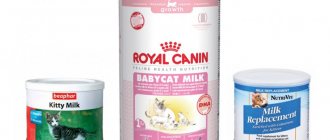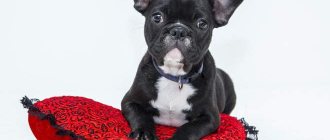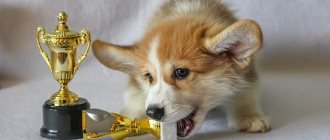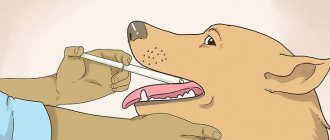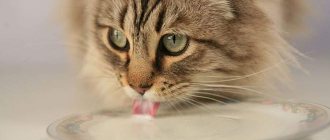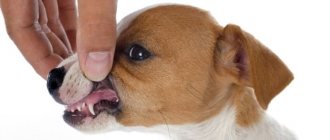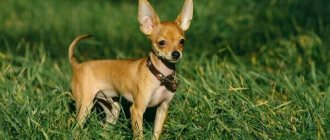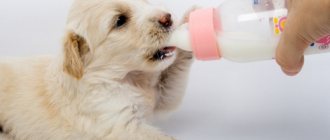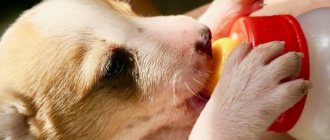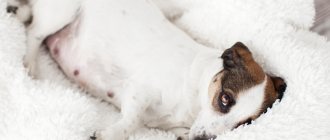Newborn puppies require special care, which increases their vitality. This applies to any breed, be it a Spitz, Yorkshire Terrier or Chihuahua. A person must prepare a nest where they will be in the first months of life. It is important to leave the bitch after giving birth so that her condition returns to normal. Correct behavior by the owner eliminates the risk of problems.
Newborn puppies
Caring for newborn puppies
The first thing the owner must prepare is a warm and dry nest where the bitch should give birth. It is advisable that it be in a separate room. When the puppies were born, the house must be made according to the following rules:
- select a cardboard box so that it does not feel crowded;
- the lid is cut off;
- The internal contents are covered with a mattress or film.
The temperature inside the house should be approximately 30 degrees. It is advisable to install an electric thermometer to maintain the temperature.
Active lifestyle of a puppy
are important . Caring for puppies is all about keeping them active.
dog's life. Without communication and active games with the owner, it is impossible for a puppy to develop harmoniously. Spend enough time to communicate with your new friend. The dog needs your communication with it. For a dog, the owner is his whole family. Games allow you to release energy, develop muscles, get your blood pumping, and keep your body healthy and strong. In the article “Raising a Puppy” you will learn more about how to organize your dog’s daily routine, how to teach it to certain actions, what to prohibit or allow your dog, and much more!
Love animals and take care of them!
Features of development
Immediately after birth, features characteristic of newborns are distinguished:
- the first weeks, when the offspring is born, there is prolonged sleep;
- from the moment of birth, the offspring is deaf, blind, and lacks the ability to walk.
At 2 weeks your eyes should open. Initially they are blue, cloudy, then darken. It is necessary to keep the eyes clean, removing purulent discharge. The ear canals open on their own by 3 weeks.
At 4 weeks teeth appear.
But for each breed the period is individual. This leads to a limitation of breastfeeding; it is time to introduce complementary foods. Attention! Many people, when caring for newborn puppies, note that they shudder in their sleep; this is a normal reaction; voluntary muscle contraction occurs.
Breast-feeding
Precautionary measures
A healthy puppy eats well, sleeps a lot and grows quickly. With mother's milk, the baby gains immunity to some infectious diseases, but if handled carelessly and not observing the basic preventive minimum, the puppy can get sick and even die. Here's how to care for newborn puppies to protect them from environmental stress:
- all pillowcases, diapers (except disposable ones), and any rags used to care for the puppy must be pre-washed and ironed;
- customers often come to the pet store with their dogs, which may be carriers of infectious diseases. Therefore, disposable diapers should be immediately transferred to a regular bag and the original packaging should be thrown away;
- before letting the bitch into the house with the puppies, you must wash her paws and belly;
- You can only touch puppies with clean, thoroughly washed hands with soap (or use disposable surgical gloves);
- You cannot enter the room where the puppies are in street clothes (it is best to wear a robe and shoe covers);
- Small children and guests should not be allowed to touch the puppies, because they can carry an infection on their clothes and skin that will destroy the entire litter;
- The room where the puppies are kept must be ventilated regularly. While the window is open, the kids should be in another room;
- the dishes from which puppies are fed must be thoroughly washed and rinsed with boiling water before each feeding;
- Puppies under 3 months should not be washed. If the baby gets dirty, the fur should be wiped with a damp cloth (or dried dirt should be combed out with a brush);
- at the age of 3-4 weeks, puppies must be given an anthelmintic drug;
- 10 days after the first deworming, babies must be vaccinated (it is advisable to go to a veterinary clinic; only an experienced dog handler or breeder can vaccinate themselves).
The age of 8 weeks is considered the beginning of the socialization period. The babies have stopped sucking milk, they are already accustomed to solid food, they are vaccinated and are completely ready to move to a new home.
Author of the article: Yurchenko O.V.
Tweet
What to do after the birth of puppies
Not every owner knows what to do with puppies after birth. If they pass naturally, the person does not interfere. The babies are left near their mother and are provided with warmth and comfort. It is forbidden to separate them, this will worsen lactation and maternal instinct in the bitch. Babies should drink colostrum fluid, which contains antioxidants, proteins, vitamins, and immunoglobulins. This also applies to large breeds, such as the German Shepherd. Don't be afraid that she will run over the kids.
Additional Information! With rare exceptions, the newborn may not be active in sucking. To prevent his vital functions from deteriorating, artificial feeding with expressed milk or formula is used.
Licking puppies
Development of puppies 0-12 months
The first year of a puppy’s life is an intense and important stage of development, not only for the dog owner, but also for the growing baby. Puppies grow and develop quickly, so mistakes in upbringing, diet, training and interaction with other family members made in the first months of life can have a tremendous impact on the dog's character in the future. According to research from the College of Veterinary Medicine at Florida State University (USA), THE STAGES OF PUPPY DEVELOPMENT CAN BE DIVIDED INTO FOUR MAIN PERIODS:
* Neonatal
(from birth to 2 weeks)
* Transitional period
(up to three weeks of age after birth)
* Socialization period
(from 3 to 2 weeks) 12 weeks)
* Juvenile period
(from 12 weeks to maturity, since the active development of the dog ends during puberty)
| Days | Physiological development | Behavioral changes | Actions of the breeder, owner |
| small supply of energy (no fat layer), physiological weight loss 10% excretion of meconium (original feces), ears, eyes closed. In the first 24 hours, the respiratory rate is 8-18 per minute, body temperature is 34.4-36 * C. In the first hours after birth, the maximum absorption of immunoglobulins in the intestines of newborns is noted. There is no shudder reflex, puppies are completely dependent on an external heat source or mother | At this stage, the puppies are very helpless and completely dependent on their mother. It is extremely important that in the first 24 hours of their life, the puppies receive their mother’s colostrum, which contains antibodies (colostral, passive immunity) that will protect the baby in the first weeks of life from infectious diseases | setting up a warm box in a semi-dark place. Immediately after the birth of each puppy, bring it to the mother's nipple (early intake of colostrum prevents the death and disease of the offspring). The ambient temperature should be at least 25 * C. Provide a source of additional heat. We weigh 2 times a day and record the indicators. |
| 5—7 | Unable to empty urine and feces (the bitch does this by licking) 1-5 days pain sensitivity is reduced, the brain is poorly developed. From the 5th day, the ear canals begin to open. The coloring of the nose begins. | They begin to find the milkiest nipples, they know the smell of the mother. They mainly sleep and eat. The sense organs that function are olfactory, gustatory, skin-temperature, and vestibular. While sleeping, puppies twitch and flinch. This motor activity during sleep is important for normal muscle development | Make sure that the bitch does not crush the puppies. Maintain the temperature in the nest at least 25*C. When artificially feeding, massage the tummies. 3-5 days, removal of dewclaws, docking of the tail. Hypothermia is one of the main factors inducing the development of cardiopulmonary failure in puppy wilting syndrome and contributes to infectious diseases in young animals |
| Recommended ambient temperature 1 week: 28-30C Week 2-3: 26.7-29.4C Week 4: 21.1-23.9C |
| 8-10 | Doubling of the initial weight, lack of thermoregulation, deafness and blindness, but developed sense of smell, touch, taste, crowding reaction, trembling reflex appears | react to touch, source of heat, squeak when something bothers them, alternate between sleeping and sucking (without dividing day and night), do not empty themselves | 8 feedings. Provide twilight, warmth and cleanliness |
| 10-15 | open eyes, pupil reacts to light, retina is poorly developed | crawl without standing on their paws |
| The hearing organs begin to function, the puppy begins to distinguish where the sound is coming from, he begins to follow a moving object, although his vision is still very weak. | They begin to stand on their paws, swaying from side to side, and many behavioral and emotional features characteristic of adult dogs begin to appear. | For the development of a puppy of this age, it is very useful to introduce him a little every day to all the manifestations of what surrounds him. In this case, the puppy should be given the opportunity to walk or crawl on different surfaces and visit places with different temperatures. In the puppy's field of vision there should be a variety of objects that he can inspect and sniff, in a word, explore. This will help develop visual acuity and motor abilities. To develop your puppy's hearing, it is useful to periodically turn on the radio or TV quietly. You can also record on a microphone various sounds that the puppy should become familiar with (knock, whistle, crackle, music, environmental sounds, human speech) and play them back to the baby. This will help develop the puppy's auditory perception. |
| 18-20 | Formation of adipose tissue, thermoregulation appears, a clear indicative reaction to external stimuli appears, defensive reflexes form, ear canals open | begin to wag their tail, flinch reaction to a sharp sound, | daily monitoring of body weight gain, keeping the nest and puppies warm and clean. Nail cutting. |
| 21-24 | The beginning of teething, the puppy hears a body temperature of 36 * -37 * C | reaction to noise, first games between puppies, signs of social behavior appear, puppies begin playing with each other with their mother and people, imitate fighting, puppies wag their tails, make many sounds | From the 21st day (3 weeks) we begin to introduce the first complementary foods into the diet. Usually we start scraping beef (well-frozen, lean beef with a knife) with a portion of 1 cherry, then increase the portions daily. Normal growth vigor and formed stool are the best indicators of good health and proper feeding. On average, puppies gain 3-4 grams per day per 1 kg of body weight; if, based on control, a smaller increase in body weight of puppies is established, additional feeding or the use of higher quality food is necessary |
| 21(3 weeks) | 1 deworming |
| 24-28 | manifestation of interest in meat, the beginning of the extinction of the sucking reflex, the transition from breastfeeding to mixed feeding | the beginning of the period of socialization (the mother begins their adaptation to adult life with the help of facial expressions and some aggressive actions. Gradually, the opportunity appears to chew, bite, the beginning of knowledge of the world, they learn to drink water | Gradually we begin to introduce dry food soaked in hot water as a separate diet. Weighing every 4 days It is important, as in the previous period, to hold the puppies in your arms and talk to them so that in the future they do not experience fear in the presence of a person |
| 30 (4 weeks) | 2 deworming (according to indications) |
| 30 | presence of teeth: canines, incisors, first and second false roots | exit from the lair | moving from a nursery to an enclosure, getting used to a diaper |
| 35 | body temperature of an adult dogSocialization period | increased motor activity, formation of daily rhythm (distinguish between day and night) respond to the nickname. The most important period for educational training. Puppies eat a variety of food. A feature of this period is the ability to quickly develop conditioned reflexes. Puppies show greater activity when becoming acquainted with the external environment, they exhibit an exploratory reflex, which is most fully expressed from 1.5 months | from 1 to 2 months weighing every 5 days |
Around the end of the fourth week of life, the puppy enters a period of socialization, which continues until the 12th week. Previous periods were characterized by changes in the primary sensory systems and motor skills, and during this period there is a rapid development of the puppy's social behavior. During this period, all sense organs are already fully functioning, and the ability to learn is significantly enhanced. Teeth are cutting through and the puppy is trying solid food. Weaning from the mother begins at approximately 4-5 weeks, which is completely completed by 7-10 weeks of age.
| 45 | certification and branding, handing out puppies, training in hygiene procedures (combing, cleaning ears, examining teeth) |
| 48-53 | the nervous system is formed | the best assimilation of new information (learning commands) the desire to learn about surrounding objects (gnaw, grab in the mouth, prattle) | human communication is necessary, do not keep him in a cage around the clock (this leads to developmental delays) |
| 55-85 | period of fear, final transition to food | avoid psychologically traumatic factors |
| 56 (8 weeks) | At the age of 8-9 weeks, puppies choose a specific place to empty their intestines and bladder by the smell of urine and feces. This is the best time to accustom your puppy to a clean house. | 3 deworming |
At the beginning of the socialization period, the puppy is very willing to explore new objects; he is especially attracted to moving objects. The thirst for exploration encourages the puppy to leave its den and get acquainted with the world around it. During this period, it becomes especially noticeable how the puppies begin to actively communicate with each other, with their mother and those around them. From the point of view of developing a dog's character and behavior, this is the most important period in a puppy's life. It is at this time that it is easiest to begin to establish a relationship with a puppy, on the basis of which all the main features of the social behavior of an adult dog will be formed.
Even a slight impact on the puppy during this period will affect its behavior in the future. How much and how a puppy communicates at this age determines whether he can easily and freely communicate with his relatives and with animals of other species. In addition to the development of social connections, during this period there is a particular danger of psychological trauma.
The sensitivity a puppy needs to form social bonds also makes him very vulnerable to psychological trauma. The puppy is easily frightened at this time.
He reacts especially strongly to loud sounds and sudden movement. Only over time do puppies begin to distinguish which situations were dangerous and which were not.
At the end of the socialization period, puppies pay less attention to their mother and are more involved with each other. In order for puppies not to be afraid of people, they need to be picked up often
, but this must be done carefully.
Careless handling of puppies will affect their attitude towards humans in the future. Their behavior will also be affected by everything they encounter during this period.
| 65—67(2 months + week) | 1 complex vaccine |
| 60 | presence of all primary teeth | puppies begin to play more and spend less time sleeping. Many games imitate hunting (puppies attack each other, their toys, they can fight among themselves, creep up slowly. They begin to control the force of the bite, since a negative reaction from other puppies and people indicates that the puppy is hurting. The sounds become more varied puppies try to bark, growl, whine to attract attention | compliance with quarantine |
| 77 (11 weeks) | deworming according to indications |
| 86 (3 months) | 2 complex vaccine with rabies, quarantine for 10-14 days |
| 96 | fully ready for independent living, socialized, vaccinated twice | we start taking them out for a walk |
| 12-16 weeks | finding your place in a team (among dogs, people), the first inclinations of leadership, the formation of individual character traits |
| 6-8 months | the follicles of the bitch are ready for ovulation, the first heat (in some bitches the first heat begins at 12-14 months, usually such bitches come into heat once a year), the final change of teeth. During this period, puppies, as a rule, have reached 80% of the size of an adult dog and their further growth and development are not so noticeable to their owners. | puberty, males begin to raise their paws | The ideal period for training. It is also important to note that classes should be short, since a puppy’s attention span is much lower than that of an adult dog. It is important that in order to reinforce the necessary behavior (commands, social behavior, feeding time, walks outside), it is necessary to use positive reinforcement (treats, food for training, praise) since this type of training is considered the most appropriate for consolidating learned skills for many years |
| 6 months deworming |
Adolescence includes the period of a puppy's life from the end of socialization to the onset of puberty (between 6 and 12 months). By this time, the puppy's ability to learn is fully developed, and communication and movement skills are gradually improved. General activity increases, the puppy devotes most of his time to research. At the onset of puberty, adolescence ends and adulthood begins. Puppies isolated from other dogs at an early stage of development have impaired social behavior. Some dogs go through an additional stage of sensory development at this time, during which they are especially susceptible to everything that happens around them. They try to avoid everything unknown and unpleasant. Such animals seem less sociable and even timid. Careful monitoring of how your puppy communicates is necessary to establish an atmosphere of trust and encourage desirable social behaviors. Harsh punishment at this time, especially if it provokes aggression generated by fear, can irreparably damage the character of the animal.
| 9-12 months | end of growth | final formation of dominance-submission relationships | 10 months deworming 12 months comprehensive vaccination with rabies (deworming no later than 10 days before vaccination) |
Important :
When you receive your puppies at 8/10 weeks of age, please keep these photos in mind. You see their bones aren't even touching yet. Have you noticed that all puppies have large flexible legs and shaky movements, their joints are entirely composed of muscles, tendons, ligaments, covered with skin on top. Bones cannot fit tightly together until they have a real socket - i.e. formed joint. And in order to protect the puppy’s bones from deformation, Nature made it so that puppies laze around and sleep a lot.
Every long or high jump or active games or bouncing run causes impacts between the bones. Playing or exercising within reason is not problematic and is normal wear and tear on the joints of any animal, but when you do it excessively or don't restrict puppies from exercising, you are not giving them the opportunity to grow normally.
You need to understand that when you let your puppy jump up and down, or run up steps, or jump off the bed, or take him on long walks/hikes, you will damage these developing joints. When you allow your puppy to slide on tile or laminate or linoleum, you are again allowing joint damage.
One small violation during the formation of a joint is enough and you can change them at once for the rest of your life. Remember that a well-built body is something that comes not only from excellent feeding and maintenance, but also from proper upbringing.
After the puppy grows up and becomes a junior, you will still have a lot of time to spend active games with him and do more complex exercises. So remain calm and patient while your four-legged children are still little puppies, and give yourself a gift that can only be given once in such a short period of time from interacting with your puppy at a tender age.
Effect of insulation
If a puppy is isolated from other dogs during the period of socialization, then there is a very high probability that in adulthood he will have problems communicating with his relatives. The dog will behave aggressively in the presence of other dogs or, on the contrary, will be afraid of them. Puppies isolated from other dogs at an early stage of development occupy a subordinate position in relation to them, they have less experience, they have difficulty getting used to a new environment. Their social behavior is disturbed, they do not know how to play, they are very often aggressive and cowardly, and they have difficulty mating. It is undesirable to take a puppy away from its mother before 7 weeks of age, because then the puppies are deprived of the necessary communication with their fellow breeders. Puppies that did not have sufficient communication with other dogs at an early age are less likely to come into contact with animals of other species, as well as humans. This risk is always present when bottle feeding orphaned puppies. Puppies that are completely deprived of human contact between the ages of 4-12 weeks are afraid of people and are very difficult to raise. In rare cases, the consequences of such deprivation can be partially corrected, but more often they are completely irreversible. A puppy that has had little contact with people before 12 weeks of age or older usually cannot become a good companion - such dogs are cowardly, aggressive and difficult to train. Puppies who were in a depleted environment during the period of socialization, where familiarity with objects and sounds was limited, do not adapt well to new conditions and have difficulty learning.
Knowledge of the world
Since puppies are not born with ready-made knowledge about the world around them, our task is to introduce them to it, educate them correctly and achieve mutual understanding. Puppies need to be introduced to a vacuum cleaner and other household appliances, cars, motorcycles, bicycles and much more. When introducing a puppy to objects, it is important that they do not give him unpleasant sensations. When the puppy is in a calm state, examine him as if you were a veterinarian: the mouth, ears, palpate different parts of the body. If your pet needs frequent grooming, start accustoming him to combs and brushes from early childhood. If you are planning a show career for your pet, accustom him to being handled (to do this, ask strangers to stroke him and look at his mouth), you need to teach the puppy to calmly accept such procedures. Social adaptation must also be carried out in relation to other animals, but this must be done after the puppy has completed a course of vaccination and quarantine. It is best to introduce the puppy to a healthy, vaccinated dog that is not infected with ectoparasites and endoparasites, who does not leave his area and has a sociable and friendly character. The influence of helmites on a dog’s health and ways to combat them anthelmintics for dogs puppy vaccination
Newborn puppies: care in the first days of life
When the bitch begins to leave the den 3-5 days after giving birth, the owner needs to inspect the offspring.
- Trimming nails. Immediately after birth they are curved and sharp. This can cause harm if you move awkwardly.
- Inspection of stool. If a disease develops, they contain blood and pus.
- Check for dehydration. Lightly pinch the newborn's skin and release it. If there is no dehydration, it will quickly smooth out. Otherwise, additional soldering is required.
- Eye opening. From this moment on, it is necessary to secure the shelter so that the kids do not accidentally harm themselves when the puppies begin to walk on their own. Additionally, it may be necessary to remove pus if the dog does not lick it.
Interesting! Mostly mom does all the work. A person must ensure that the surrounding area is safe.
Appearance and characteristics of newborn puppies
The appearance of Pomeranian Spitz puppies does not cause affection: the head of newborn puppies is short and wide, the eyes are closed as are the ear canals, the ears are small and pressed to the head. But these babies have a large mouth, however, without teeth. The body is elongated and has a cylindrical shape, the tummy is voluminous, the legs are small and short. Their skin is soft and flexible, their fur is very short and thin, and their body is loose. If the puppy is white or light in color, then pink skin shines through the fur (if the skin is bluish, it means the baby is weak and needs special care), dark-colored puppies usually have dark-colored skin. Of course, these babies are completely helpless and clumsy.
But, despite this, puppies can easily find their mother’s udder and start sucking - the food instinct is developed to the maximum in newborn puppies. Having attached itself to one of the nipples, the puppy begins to make peculiar pushing movements with its paws, which act as a massage and stimulate milk production in the bitch. If some puppy is not able to suckle on his own, you need to help him: first, massage the dog’s fullest nipple a little and squeeze out a drop of colostrum so that the baby can smell it, and then place the weak puppy on the nipple (and if necessary, even put the nipple in his mouth).
Sometimes puppies are born so weak that they cannot suckle - such puppies need to be fed artificially every two hours from a syringe, either with milk expressed from the bitch (especially important in the first days, when colostrum has not yet been replaced by milk), or with a substitute for the bitch's milk until the baby has gained enough strength to feed yourself. For one feeding, 1 ml of milk or a little less is enough.
Bitch after giving birth
Carefully examine the bitch after giving birth. Pay attention to the following criteria:
- there should be milk in the mammary glands, but there should be no stagnation, which increases the risk of mastitis;
- postpartum discharge should be free of blood and pus, which indicates pathology (dead puppy in the birth canal, bacterial infection);
- The dog’s body temperature is normal - 38-39 degrees, hyperthermia develops due to inflammation;
- behavior is stable, mother feeds and licks the puppies, warms them (aggression, anxiety, excessive weakness are a sign of illness).
If there are deviations in health, contact a veterinarian. Do not give medications on your own.
Puppy hygiene procedures
Caring for a puppy is also reflected in hygienic grooming procedures. It is necessary to bathe the puppy with special shampoos for puppies. They take into account that a puppy's coat is softer than an adult dog's. If you are bathing your puppy with shampoo for an adult dog, then the shampoo should be diluted with water. You need to bathe your puppy no more than once a month. Blow dry your puppy on low setting. Get your puppy used to brushing, especially if your breed has thick, fluffy fur. Some breeds require special haircuts and special coat care, so it is advisable to contact specialists, where your puppy will be provided with professional grooming services, given the correct haircut, and advice on how to care for your pet’s coat.
If the dog does not feed the babies
If your dog gives birth, it is important to know what to do next. There are times when a bitch refuses to breastfeed. The owner must use artificial nutrition for the babies to survive.
What to feed
Veterinary pharmacies sell special mixtures to replace bitch milk. The following companies are used:
- Lactazor;
- Royal Canin Mini;
- Welpenmilch.
Each product comes with instructions for diluting the powder. You can use homemade ingredients if a similar mixture is not available:
- boiled goat milk;
- glucose solution in water;
- a mixture of milk and chicken yolk.
Professional breeders prefer to use a mixture that contains all trace elements, minerals, and vitamins.
How to feed
For feeding you will need a syringe with a rubber nozzle, a pipette, and a bottle with a small nipple. The mixture is given every 3 hours, it should be heated to 38-40 degrees.
How many
The newborn is pre-weighed to find out how much formula he will need. Usually 1 ml per feeding is enough to keep babies full. From 2 weeks the volume is increased to 10 ml.
Interesting! In the first week, puppies may lose weight, but this is normal.
How often
For healthy, strong puppies, feeding every 3 hours a day is sufficient. If they are low weight, the number of feedings is increased to every 1.5 hours.
Lure
In the first 3 weeks of life, breastfeeding is carried out. The owner must ensure that babies latch onto the nipple when eating. The first complementary feeding begins at 3-4 weeks. The following rules apply:
- small portions of food once a day, observing the baby’s reaction and feces;
- By week 6, add 1 more complementary food.
For newborn puppies, the following products are allowed to be added in small quantities:
- turkey meat, chicken, veal;
- eggs;
- dairy products;
- ocean fish without bones.
From 1.5 months, babies should eat 6 times a day in small portions. Three of them should be meat, the rest - dairy. After this point, cereals are added.
Massage
After feeding, it is necessary to massage the puppies' tummies to ensure stable bowel function. Up to 3 weeks, babies cannot urinate on their own and empty their bowels.
Active movements help speed up digestion and normal bowel function. You can imitate the movements of a mother dog's tongue using a piece of soft cloth , after dipping it in warm water. Use a clockwise circular motion to massage your puppy's tummy for five minutes before and after feeding.
It is also necessary to massage the baby's butt. Regular hygiene is also mandatory. After the puppy goes to the toilet, use a soft cloth to collect the discharge to prevent skin irritation. The water temperature should not exceed 36 degrees.
Massage for a newborn puppy for bowel movements:
Be sure to monitor the behavior and appearance of your orphans, because their bodies do not yet have enough strength to fight diseases, such as intestinal infections. Even due to such a minor disease, the puppy can die in the first day. When intestinal infections appear, an unpleasant sour smell will appear in the bed, and yellow marks will remain around the butt.
The main cause of infection is usually inflammation of the navel. Bacteria are introduced when a dog with unhealthy teeth chews the umbilical cord. To avoid illness, lubricate the wound on the navel with brilliant green 2 times a day .
How to properly care for puppies in the first week of life
After the birth of the babies, the owner must monitor the behavior of the mother and newborns. She must cover them and provide access to breastfeeding. If this does not happen, the person warms up the box on his own and uses artificial feeding.
If the bitch has developed a maternal instinct, she performs further actions independently. With the help of licking, it removes amniotic particles, pus from the eyes, and stimulates the digestive tract. The owner must ensure peace, correct room temperature, and the availability of diapers.
Newborn blindness
Determination of gender
An experienced veterinarian will be able to accurately determine the sex within a week after birth. Everyone else will have to wait a little longer until the genitals become more visible.
Males and females are distinguished by the structure of the genital organs and behavioral characteristics, so after 8-10 weeks there will be no problems with sex determination. Boys will already have clearly visible penises, while girls will have a fully formed vulva. However, if you cannot wait that long, the determination can be made earlier, at about 1 month.
Inspection is carried out in compliance with safety precautions:
- Wash and dry your hands thoroughly and warm them.
- Take the puppy and observe the mother's reaction. If she objects aggressively, it is better to carry out the procedure later.
- Gently turn the dog over onto his back. If the puppies are large, then it is better to carry out the operation on a warm towel; if they are small, then it is possible to carry out the operation by weight in the palm of your hand.
- Pay attention to the genital area. Representatives of both sexes have one bulge - the umbilical cord, but just below there will be either a developing penis, which looks like a small seal and tubercle, or a vulva, that is, a second hole.
The easiest way to distinguish newborns is by the number of holes in the lower abdomen. Boys have one, and girls have two.
Proper care for puppies at 1-2 months
By this time, the babies began to move around and eat solid food. When puppies begin to defecate on their own, it is necessary to accustom them to a diaper so that they do not relieve themselves in other places. Mark a place for the toilet.
The amount of complementary foods is reduced to 3 times a day. They get vaccinated. The children are gradually taken outside. After this point, you can make documents for each puppy.
First feeding
Puppy toilet area
The puppy is 1 month old, care during this period also includes developing the skill of going to the toilet in a certain place. Puppies do not defecate in the same place they eat. Therefore, select a special place for the toilet away from food bowls, and lay a newspaper or diaper there. Having gone to the toilet in this place, the puppies will be guided by the smell and will get used to going to the toilet in a certain place.
From the age of 45 days, puppies need more attention from you. You need to play and communicate with them more. At this age, character begins to emerge, leaders, more active or calmer puppies are identified. This is a very important period; at this time, the puppy’s nervous system and psyche are formed, which depends not only on innate genes, but also on the animal’s experience of communicating with humans. Socialization of animals occurs.
Behavior of puppies in the first few weeks after birth
Raising puppies from birth should be done in stages, according to rules, so that they remain healthy. Their behavior changes as they grow older, according to periods:
- 1 week - constant sleep;
- 2-3 weeks - eyes open, but the muscular frame is not strong enough to move around the entire territory;
- 4-6 weeks - babies move actively, consume breast milk and complementary foods, and can play with each other.
Attention! The owner must monitor whether there are weak individuals among the newborns. They require special care and frequent feeding.
Label
In the first days of life, it is necessary to develop a system of special marks that make it possible to immediately distinguish animals from each other.
In the beginning, breeders use a ribbon system. The cubs are not yet very mobile, so they do not pick off colorful pieces of material. But after 14 days this method becomes unreliable. It will be most convenient to combine the notes and the necessary care procedures.
At the age of 2 weeks, a manicure is given for the first time, slightly trimming the sharp tips of the claws. It is at this point that you can mark the animals by trimming one of the claws a little more.
Starting from 1 month, usually at the age of 5-6 weeks, representatives of various breeds undergo a branding or microchipping procedure, which are necessary for further identification and correlation with a specific genus. Both options perform approximately the same function, but there are some peculiarities:
- A brand is a tattoo placed on the inside of the ear or on the lower abdomen. The set of numbers and letters cannot be deciphered in any way; it is akin to car license plates. However, they are all included in the database. Branding makes it much easier to track missing or stolen pets. However, this system is gradually becoming a thing of the past. It is mainly used in countries where the technical support of veterinary centers is far from modern.
- Chipping is the implantation of a microchip under the skin in the withers area. A small microcircuit does not cause any discomfort to the pet and does not affect its well-being in any way. However, it is with the help of this system that representatives of breed families in Europe are tracked. Finding a lost or stolen microchipped pet is much easier. Moreover, when crossing the borders of the European Union, microchipping at least 7 days before the start of vaccinations is a mandatory condition.
Possible problems
Immediately after birth, problems may arise that the owner should pay attention to:
- one of the babies may turn out to be weak and underweight;
- refusal of the mother to breastfeed or the offspring;
- increased body temperature in the mother and babies, which may mean the development of complications and infectious diseases;
- suppuration of the eyes of the offspring;
- one offspring could be stillborn, but not emerge through the birth canal, which would cause a sharp deterioration in the dog’s well-being.
To resolve such problems, it is better to contact a veterinarian. He will accurately diagnose and prescribe treatment.
Pus and redness of the eyes
Immediately after the birth of pug puppies, Jack Russell, Yorkie, dachshund and other breeds, the owner must take care and care for them and the mother. It is important to use the first feeding correctly and observe the temperature regime. When puppies begin to walk after birth, it is necessary to fence off the den from dangerous objects. If preparation and subsequent care are carried out correctly, the babies will grow up quickly, each of them will be viable.
Ambient temperature and its significance for newborn puppies
Ambient temperature plays a very important role in the first days of puppies’ lives: without exaggeration, we can say that the life of babies is completely dependent on external sources of heat, which are the warmth of their mother’s body or a heating pad. This dependence is caused by the lack of an established thermoregulation system and trembling reflex in puppies during the first week of life.
Newborn puppies have a body temperature ranging from 34.4°C to 36°C. To avoid hypothermia and maintain body temperature at an acceptable level, puppies try to stay as close to each other as possible. The puppies' body temperature will begin to decrease even if the ambient temperature is less than 30°C, for example when the mother dog goes out for a walk/feeding. Such short-term cooling (moderate hypothermia)
stimulate metabolic processes in the body of babies, but puppies become lethargic, the milk they eat stops being absorbed, the heart begins to contract more slowly, and the rectal temperature drops.
Prolonged cooling (severe hypothermia)
can pose a danger to the life of newborn puppies, since it entails a significant decrease in respiratory activity and cardiac activity, their reflexes practically fade, as a result of which the puppies stop sucking milk.
To avoid such problems, simply place a heating pad in the nest immediately after giving birth, but keep in mind that there should be enough free space in the nest for the mother bitch to move into if she gets hot. It is very important to follow safety precautions when using a heating pad!
Training and socialization of a puppy from newborn to one week old
A newborn puppy is too young to undergo any training, but there may be some things you can do to get her accustomed to people and her surroundings. If the mother allows, touch the puppies regularly for short periods of time.
Make sure that the puppy does not come close to his mother for more than a few minutes. You can use this time to cuddle and pet your puppy, introducing him to the smell and feel of people and the environment.
